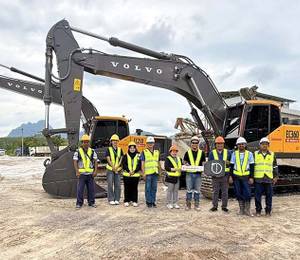Singapore’s National Environment Agency (NEA) has awarded the main engineering, procurement and construction (EPC) contract for its Tuas Nexus Integrated Waste Management Facility (IWMF) to the consortium comprising Keppel Seghers Engineering Singapore Pte Ltd, China Harbour (Singapore) Engineering Company Pte Ltd and ST Engineering Marine Ltd. The total value of this contract is about S$1.5 billion.
Under the contract, the consortium will design, construct and commission a 2,900 t/day Waste-To-Energy (WTE) Facility and a 250 t/day Materials Recovery Facility (MRF) as part of IWMF Phase 1 development. The MRF will sort household recyclables collected under the National Recycling Programme (NRP). A separate IWMF Phase 1 EPC contract for an 800 t/day Sludge Incineration Facility and a 400 t/day Food Waste Treatment Facility is in the tender phase and will be awarded later this year.
In a separate press release, Keppel Seghers states that the company holds 48% share of the works, while China Harbour and ST Engineering Marine will be approximately 31% and 21% respectively. The WTE and MRF will be amongst the largest of such facilities in Singapore when they are completed in 2024.
The WTE facility will feature Keppel Seghers’ air-cooled grate, boiler design, and advanced combustion system. In addition, the facility’s wet flue gas cleaning system will ensure the facility’s emissions comply with Singapore’s regulatory requirements as well as standards. As the consortium lead, Keppel Seghers will also be responsible for the overall project management.
China Harbour will undertake the civil, structural and landscaping scope of the project, while ST Engineering Marine will be responsible for the construction of the MRF, power-island and the balance of plant.
The consortium will work closely with NEA, as well as their consultants - a multi-disciplinary consultancy team led by Black & Veatch and AECOM, in association with Ramboll - for the design, construction and commissioning of the project.
According to NEA, the IWMF is an integral part of its long-term plan to meet Singapore’s solid waste management needs. The facility will be equipped with state-of-the-art solid waste treatment technologies to improve energy and resource recovery from waste. It will also be Singapore’s first integrated facility to treat incinerable waste, source-segregated food waste and dewatered sludge from PUB’s Tuas Water Reclamation Plant (Tuas WRP) at a single facility. PUB is the national water agency of Singapore.
The IWMF will be co-located with PUB’s Tuas WRP to collectively form the Tuas Nexus. The integration of solid waste and used water treatment processes at Tuas Nexus will enable both agencies to harness various synergies to further improve overall plant performance and optimise land use.
Some of the key Tuas Nexus synergies include the co-digestion of IWMF source-segregated food waste with Tuas WRP’s dewatered sludge to improve biogas production. The biogas produced will then be combusted at IWMF to improve overall plant thermal efficiency and boost electricity generation. The electricity generated by IWMF will be sufficient to sustain the operations of Tuas Nexus and excess electricity will be exported to the grid. The amount of excess electricity exported to the grid by IWMF when it is fully operational will be able to power up to 300,000 four-room HDB apartments.
”The concept of the Tuas Nexus has stirred a lot of interest in the global waste management industry, as well as in the used water treatment industry. It marks a new chapter for solid waste and used water treatment here in Singapore based on a circular economy approach. It is the first greenfield project that involves the development of two mega waste treatment facilities located side-by-side to exploit co-location synergies, and one that will spin off many similar circular economy developments in the years to come,” said Tan Meng Dui, CEO of NEA.
Singapore aims to reduce the average daily amount of waste sent to Semakau Landfill by 30%, from 0.36 kg/capita in 2018 to 0.25 kg/capita by 2030. The establishment of IWMF is expected to help the country achieve long-term environmental sustainability goals by improving resource and energy recovery from waste.
Image 1: NEA
Image 2: NEA and PUB













